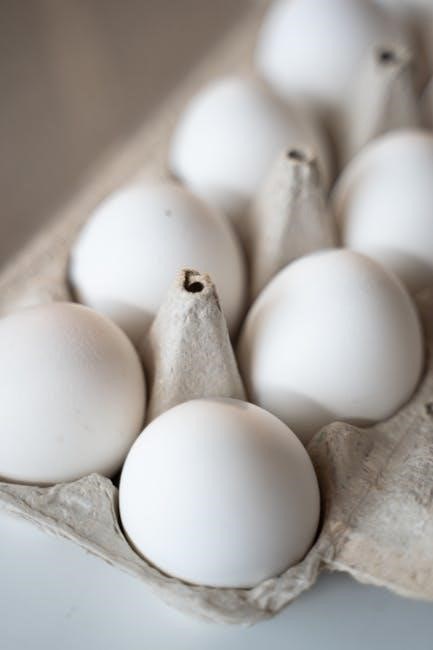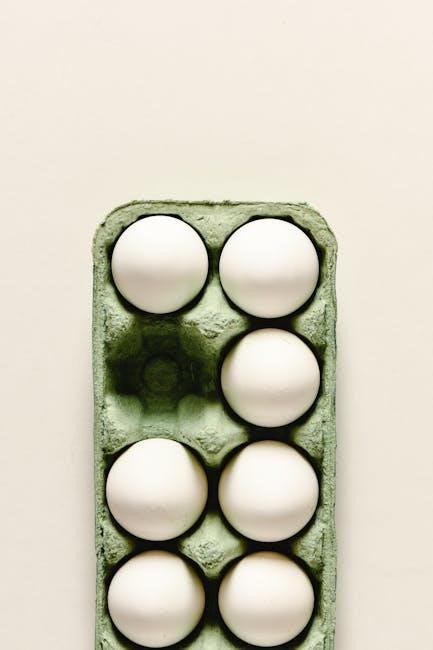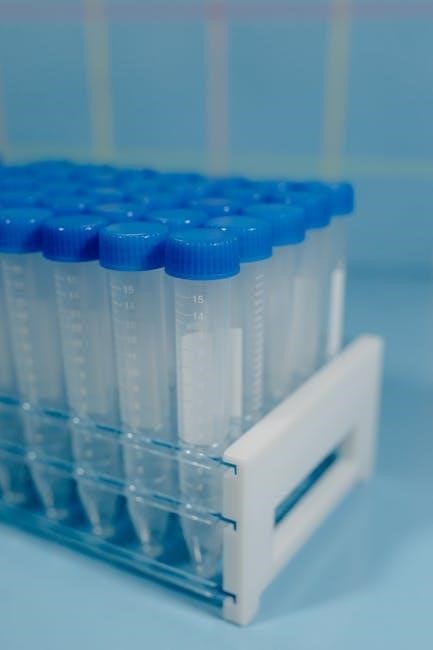The Clean 15 and Dirty Dozen lists, compiled by the EWG, help consumers identify produce with the highest and lowest pesticide residues, promoting healthier and informed shopping choices.
Overview of the EWG’s Shoppers Guide
The EWG’s Shoppers Guide to Pesticides in Produce is a valuable resource for consumers, ranking fruits and vegetables based on pesticide residue levels. Updated annually, it categorizes produce into the Dirty Dozen (highest in pesticides) and the Clean Fifteen (lowest in pesticides). The guide is based on data from the U.S. Department of Agriculture (USDA), analyzing pesticide contamination across hundreds of samples. By highlighting which foods are most and least likely to contain pesticide residues, the guide helps shoppers make informed decisions. It encourages buying organic for the Dirty Dozen and opting for conventional for the Clean Fifteen, balancing health and budget. The guide is widely recognized for its accessibility and practicality, making it easier for consumers to reduce their exposure to potentially harmful chemicals. It is available as a free PDF download, ensuring widespread accessibility for health-conscious shoppers.

Importance of Understanding Pesticide Residue in Produce
Understanding pesticide residue in produce is crucial for safeguarding health, especially for vulnerable populations like children and expectant mothers. Pesticides, while designed to protect crops, can pose risks if consumed in significant amounts. Residues have been linked to potential health issues, including neurological effects and developmental delays in children. The EWG’s Clean 15 and Dirty Dozen lists provide a clear guide to minimize exposure. By knowing which fruits and vegetables are more likely to contain higher pesticide residues, consumers can make informed choices, such as opting for organic options when necessary. This awareness not only protects individual health but also promotes a safer food system. Staying informed about pesticide residues empowers shoppers to balance nutrition, safety, and budget effectively, ensuring a healthier diet for themselves and their families.

The Dirty Dozen: Highest in Pesticides
The Dirty Dozen lists produce with the highest pesticide residues, emphasizing the importance of buying organic to reduce potential health risks from chemical exposure.
Top 12 Fruits and Vegetables with the Most Pesticides
The Dirty Dozen list identifies the top 12 fruits and vegetables with the highest pesticide residues. In 2023, strawberries, spinach, and kale topped the list, followed by peaches, pears, and nectarines. Apples, blackberries, and cherries also ranked high. Grapes and bell or hot peppers were included as well. The EWG found that conventional versions of these foods often contain multiple pesticide residues, with some testing positive for 10 or more different chemicals. This highlights the importance of choosing organic options for these items to minimize exposure to potentially harmful pesticides. The list serves as a critical guide for consumers seeking to reduce their intake of chemical residues in their diets.

Why These Foods Should Be Bought Organic
Foods on the Dirty Dozen list are highly contaminated with pesticide residues, making organic options a safer choice. Organic produce adheres to stricter farming standards, avoiding synthetic pesticides. This reduces exposure to potential health risks, especially for children and expectant mothers. Buying organic for these items minimizes the intake of harmful chemicals, promoting long-term health benefits. The EWG recommends prioritizing organic purchases for the Dirty Dozen to protect against toxic pesticide residues, ensuring a cleaner and healthier diet.
2023 Dirty Dozen List: Key Highlights

The 2023 Dirty Dozen list, released by the EWG, highlights the top 12 fruits and vegetables with the highest pesticide residues. Strawberries, spinach, and kale topped the list as the most contaminated produce. Pears and apples also ranked highly, showing significant pesticide exposure. Nectarines and peaches were added to the list, reflecting increased pesticide residues compared to previous years. The list emphasizes the importance of choosing organic options for these items to minimize exposure to harmful chemicals. These findings are based on USDA data analysis, which revealed alarming levels of pesticide residues on non-organic produce. Buying organic for these Dirty Dozen items is crucial to reducing potential health risks associated with pesticide consumption.

2025 Updated Dirty Dozen List: What’s Changed?
The 2025 Dirty Dozen list reveals significant changes in pesticide residue levels across various fruits and vegetables. Spinach has moved to the top of the list, overtaking strawberries, which remained a high-priority item. Kale, collard, and mustard greens continue to rank highly, while pears and apples have moved up, indicating increased pesticide exposure. Blackberries and grapes have also been added to the list, reflecting higher contamination levels compared to previous years. These changes highlight the fluctuating nature of pesticide use in agriculture. The updated list underscores the importance of choosing organic options for these items to reduce exposure to potentially harmful chemicals. Consumers are encouraged to refer to the latest EWG guide for the most current information on pesticide residues in produce.
The Clean Fifteen: Lowest in Pesticides
The Clean Fifteen highlights produce with the lowest pesticide residues, offering a cost-effective option for consumers to purchase conventionally grown items safely.
Top 15 Fruits and Vegetables with the Least Pesticides
The Clean Fifteen list features avocados, sweet corn, pineapples, onions, papayas, and sweet peas, among others, which consistently show minimal pesticide residues, making them safe to buy non-organic.
Safety of Buying Conventionally Grown Clean Fifteen
Produce on the Clean Fifteen list is considered safe to buy conventionally grown due to its low pesticide residue levels. According to the EWG’s analysis of USDA data, these fruits and vegetables consistently show minimal contamination, making them a cost-effective and healthy choice for consumers. For example, avocados, sweet corn, and pineapples often have negligible pesticide residues, even when not grown organically. This makes conventionally grown Clean Fifteen produce a practical option for those seeking to reduce pesticide exposure without the higher cost of organic options. The EWG emphasizes that residues on these foods are well within EPA safety limits, ensuring they are safe for consumption. This list is particularly useful for budget-conscious shoppers who want to make informed decisions about their grocery purchases while maintaining a healthy diet.
2023 Clean Fifteen List: Key Highlights
The 2023 Clean Fifteen list, released by the EWG, highlights the top 15 fruits and vegetables with the lowest pesticide residues. Avocados, sweet corn, and pineapples topped the list, showing minimal contamination. Onions, papayas, and sweet peas also ranked high, with pesticide residues well below EPA safety standards. These findings emphasize the safety of purchasing conventionally grown produce from the Clean Fifteen, offering consumers a budget-friendly way to reduce pesticide exposure. The list is based on USDA data and provides a clear guide for shoppers aiming to make healthier choices without the need for organic options. This annual update helps consumers stay informed about pesticide levels in their food, promoting a healthier and more sustainable diet.
2025 Updated Clean Fifteen List: What’s Changed?
The 2025 Clean Fifteen list introduces notable changes, reflecting updated pesticide residue data. Avocados remain at the top, while sweet corn and pineapples have moved up in rankings. Onions and papayas have shifted slightly, and kiwis have been added as a new entry. These adjustments highlight the evolving nature of pesticide contamination in produce. The inclusion of kiwis underscores the importance of annual updates to reflect current data trends. Consumers can use this list to make informed decisions about purchasing conventionally grown produce, ensuring they minimize pesticide exposure without the need for organic options. This update reinforces the value of the Clean Fifteen list in promoting healthier and cost-effective grocery shopping.

How the Lists Are Compiled
The Environmental Working Group (EWG) compiles the Clean 15 and Dirty Dozen lists using USDA data on pesticide residue levels across fruits and vegetables, ranking them based on contamination levels and pesticide types detected.
EWG’s Methodology for Ranking Produce
The Environmental Working Group (EWG) ranks produce based on pesticide residue data from the USDA. They analyze thousands of samples, considering factors like residue levels, the percentage of samples with detectable pesticides, and the average concentration of pesticides. Produce is then categorized into the Dirty Dozen (highest residues) and Clean Fifteen (lowest residues). The methodology prioritizes produce with higher pesticide loads, focusing on toxic chemicals and their potential health risks. By evaluating the number of different pesticides detected and their average concentrations, the EWG provides a clear guide for consumers to make informed decisions about organic and conventional produce purchases.
Role of USDA Data in Pesticide Analysis
The USDA collects extensive data on pesticide residues in fruits and vegetables through its annual pesticide monitoring program. This data is crucial for the EWG’s analysis, as it provides detailed information on residue levels, types of pesticides detected, and the frequency of contamination across various produce samples. The USDA tests thousands of produce samples each year, covering a wide range of fruits and vegetables. This data is then analyzed to determine which produce items have the highest and lowest pesticide residues, forming the basis for the Dirty Dozen and Clean Fifteen lists. By relying on USDA data, the EWG ensures that its rankings are based on rigorous, scientifically sound research, helping consumers make informed choices about their produce purchases to minimize pesticide exposure.
Benefits of the Clean 15 and Dirty Dozen Lists
The Clean 15 and Dirty Dozen lists help consumers reduce exposure to potentially toxic pesticides while enabling cost-effective shopping by identifying when organic purchases are most beneficial.
Reducing Exposure to Potentially Toxic Pesticides
The Clean 15 and Dirty Dozen lists empower consumers to make informed choices, minimizing exposure to pesticide residues linked to potential health risks. By prioritizing organic options for the Dirty Dozen, such as strawberries, spinach, and kale, individuals can significantly reduce pesticide intake. These lists highlight produce with the highest and lowest pesticide residues, respectively, based on USDA data. The Dirty Dozen often includes items like pears, apples, and blackberries, which consistently show higher contamination levels. In contrast, the Clean Fifteen, featuring avocados, sweet corn, and pineapples, offers safer conventional choices. This guidance helps consumers balance health and budget, ensuring they avoid unnecessary pesticide exposure without sacrificing access to fresh produce.
Cost-Effective Shopping: When to Buy Organic
Understanding when to buy organic can significantly impact both your health and budget. The Dirty Dozen list identifies produce with the highest pesticide residues, making organic options a wiser choice for these items. For example, strawberries, spinach, and apples often top the list, and buying them organic reduces exposure to potentially harmful chemicals. On the other hand, the Clean Fifteen, such as avocados, sweet corn, and pineapples, typically have lower pesticide residues, making conventional purchases more cost-effective. By prioritizing organic for the Dirty Dozen and opting for conventional Clean Fifteen items, shoppers can balance health and affordability. This strategic approach ensures consumers minimize pesticide exposure without unnecessary expenses, promoting a healthier and more budget-friendly diet.

Practical Tips for Shoppers
Shoppers can use the Clean 15 and Dirty Dozen lists to make informed choices, prioritizing organic for high-pesticide items and saving on low-residue produce for cost-effective, healthier shopping.
How to Use the Lists for Healthier Grocery Shopping
Using the Clean 15 and Dirty Dozen lists is a simple way to make healthier grocery choices. Start by downloading the EWG’s free PDF guide, which outlines the rankings of fruits and vegetables based on pesticide residue. Before shopping, check which items are on the Dirty Dozen list, such as strawberries, spinach, and apples, and prioritize buying these organic to reduce pesticide exposure. For produce on the Clean 15 list, like avocados, sweet corn, and pineapples, conventional options are safer and more cost-effective. By referencing these lists, shoppers can balance their budgets while minimizing their intake of potentially harmful pesticides. This informed approach ensures healthier meals and peace of mind for consumers of all ages.
Understanding Labels: Organic vs. Conventional
Understanding the difference between organic and conventional labels is crucial for making informed shopping decisions. Organic produce is grown without synthetic pesticides, herbicides, or fertilizers, and must meet strict USDA standards. Conventional produce, while still regulated, may contain residues of these chemicals. The Dirty Dozen list highlights fruits and vegetables with the highest pesticide residues, making organic options a safer choice for these items. In contrast, the Clean Fifteen list includes produce with the lowest pesticide residues, where conventional options are generally acceptable. By understanding these labels, shoppers can decide when to prioritize organic for health reasons and when conventional is a cost-effective alternative. This knowledge empowers consumers to make choices that align with their dietary preferences and budget.
The Clean 15 and Dirty Dozen lists provide essential guidance for consumers, highlighting key produce items with the highest and lowest pesticide residues, based on the latest EWG analysis.

Final Thoughts on the Importance of the Clean 15 and Dirty Dozen
The Clean 15 and Dirty Dozen lists are invaluable resources for consumers seeking to minimize pesticide exposure while making informed, cost-effective choices. By highlighting produce with the highest and lowest pesticide residues, these lists empower shoppers to prioritize their health and budget. The Dirty Dozen emphasizes the importance of buying organic for certain fruits and vegetables, while the Clean 15 offers reassurance that conventionally grown options are safer and more affordable. These rankings, based on rigorous USDA data analysis, demonstrate the EWG’s commitment to transparency and public health. Ultimately, the lists serve as a practical guide for navigating the complexities of modern food choices, helping consumers make smarter decisions for themselves and their families.

Call to Action: Download the Free PDF Guide
Take the first step toward healthier shopping by downloading the free EWG Clean 15 and Dirty Dozen PDF guide! This essential resource provides a handy list of fruits and vegetables ranked by pesticide residue levels, helping you make informed decisions at the grocery store. Updated annually, the guide includes the latest rankings, tips for reducing pesticide exposure, and practical advice for balancing your budget and health. With the Clean 15 and Dirty Dozen lists at your fingertips, you’ll know exactly when to choose organic and when conventional produce is safe. Don’t miss out on this valuable tool for a healthier lifestyle—download your free guide today and start shopping smarter!
Download the Clean 15 and Dirty Dozen PDF Guide here.

No Responses